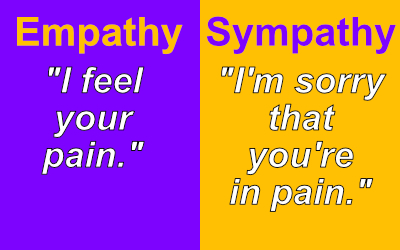This is Part 5 of a multi-article series on emotional intelligence in engineering. Part 1 is here: Engineering is More than IQ.
Think back to the best teammates you’ve ever had. The ones you always wanted to work with or play with. Or, for that matter, just be around.
In sports, they probably weren’t the fastest, strongest, or best player. On your team at work, they’re probably not the smartest or even the hardest worker. Sure, you wanted those people on your team, too. But, if you’re anything like me, the ones you really wanted were the ones who could deliver and who made you feel better about yourself and the team.
They gave you a pep talk when you needed one. They cheered when you did great. The stopped to ask if they could help when you looked perplexed. They could see into you – if even just a little bit – and knew what you needed when you needed it. In short, they had empathy.
Focusing Outward
The last three installments of this emotional intelligence series focused inward – toward ourselves. In this article and the next, we change the focus and redirect our emotional encounters out toward other people.
After building up your inward facing emotional skills, you’ll be in prime condition to examine the emotions of others.

Empathy is not the same as sympathy. See the chart to the right. It’s an awareness of the feelings of others and well as the ability to analyze or simply appraise them. When that awareness and contemplation is in place, human connections are forged and teams are built. Without it, connections are lost and teams dissolve.
An Engineer Lacking Empathy
Years ago, I had a rather painful conversation with a co-worker and fellow engineer named Matt. Obviously, that isn’t his real name. You’ll see why in a minute.
Earlier in the day, the project manager on my team pulled me aside after a meeting to talk.
“Matt is an ***hole,” Lindsey (again, not her real name) said. She didn’t preface the swear word with her usual, “pardon my French” so I knew she was upset.
“You need to fix his ****ing **** before I do.” Yeah, it was bad.
During a pre-demonstration dry run, Lindsey had seen some issues with the project and called Matt in for a conversation. The issues were fairly minor in the grand scheme of things but would have led to confusion on the part of our customers.
Lindsey worked hand in hand with our clients. She had even been one of our clients before we hired her, so she was often the one to champion their causes. She was emotionally connected with the clients and empathized with their need for an easy to use solution.
From the other engineers, I found out that she had presented a reasonable argument for delaying the project by two weeks to resolve the points of confusion. Matt, the lead engineer, flatly denied her request. This escalated as Lindsey made a case for the clients and pretty well ended when Matt said, “**** them. They need to get better with computers. That will fix the problem.”
When Matt and I spoke, he was fully aware that he was angry and his emotional reaction had not helped the situation. What he was not aware of, though, was his inability to understand the feelings and needs of others.
I wish the story had a better end, one where I helped Matt see that developing empathy for our clients would make him a better developer and a better leader for our team. I was never able to explain that in a way that swayed him from his thinking.
The last time I talked to Matt – about a year ago – he was still a lead engineer. And he was still frustrated because he had applied for but not received another promotion to a management position.
A Basic Leadership Skill
Leadership requires reaching people, moving them to action, helping them see the goal … all while caring for them. If you’re not aware of others’ emotions, how do you know you’ve reached them? How will you know how they might react to your decisions? How will you connect to them as individuals and connect them to each other?
Of the many skills a leader needs, I always put empathy near the top.
Author and speaker Simon Sinek said, “Leadership is not about being in charge. Leadership is about taking care of those in your charge.”
Empathy is the first step in caring for others. Through it, you open up communication channels and develop understanding. You build strong relationships. With time, empathy becomes caring, concern, and compassion.
How to Improve Your Empathy
Engineers are not always known for empathy. In fact, according to a study from Rice University, the education process for engineers can lower empathy. Early in my career, I jokingly referred to a less-than-empathetic fellow engineer as “emotionally tone deaf.” Unfortunately, that’s a term I’ve used frequently since then.
Facts and figures form the absolutes engineers use on a daily basis while crafting the world around us. That world, of course, if filled with people. People who need to be cared for. Improving your empathy will help you build a better future.
- Put yourself in someone else’s shoes – This is the first step toward empathy. And this is an easy exercise you can do now before you need it. When you see an upset child at the grocery store (you know you’ll see at least one on your next trip,) put yourself in their position. Imagine what they’re feeling. Don’t dismiss them as an annoying, bratty child. Do the same with coworkers and friends – whether their emotions are high, low, or in the middle. Watch people at the airport, the grocery store, the park. Attempting to experience a wide range of emotions will help you stay in touch with those around you and make empathy an automatic skill.
- Read their body language – Learning to read body language will help you decipher the feelings of others.
- Respond with emotion – When you can feel the emotions of others, respond to them with emotional intent. Acknowledge their feelings when you speak. Never downplay emotions. As an engineer, it’s easy to do that. I know because I’ve done it too many times.
Final Takeaway
Engineers create tomorrow. Empathetic engineers create an even better tomorrow because they are emotionally connected to the well being of others. When they’re connected to others, they make work a better place to be. They connect team members to themselves and the organization. Turnover drops. Satisfaction rises. Leaders grow. And we all need more leaders.
Featured photo by Jakob Owens on Unsplash

Author: Tracy Thomason
Agile project manager by day, craft beer drinker by night, and avid reader anytime I can get 5 minutes alone with my Kindle.
More posts by Tracy

